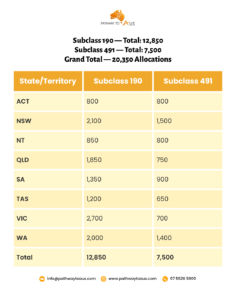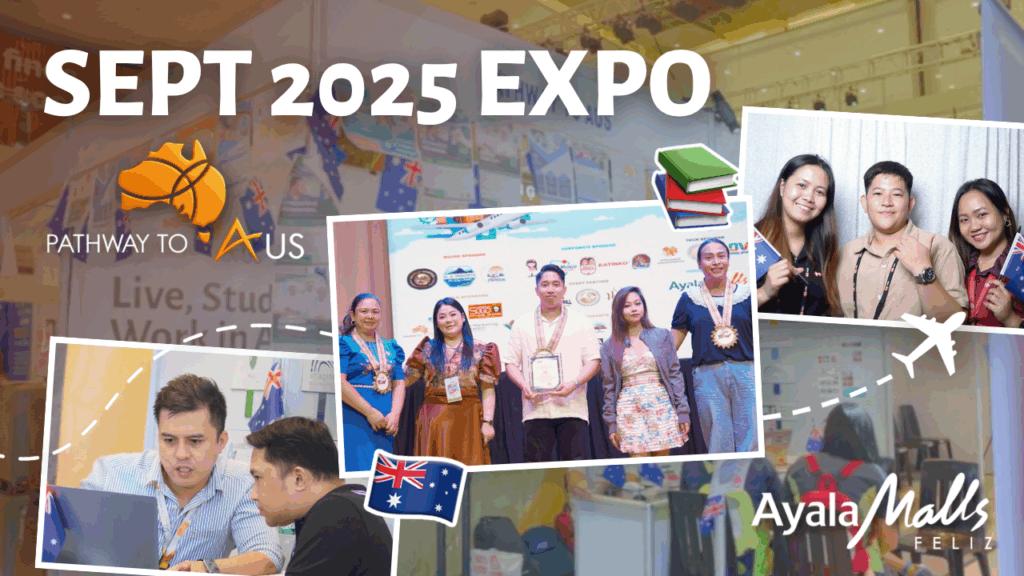What Are State and Territory Nomination Allocations?
Each year, the Australian Government gives every state and territory a fixed number of potential migrants they can nominate for these 2 visas:
- Skilled Nominated (Subclass 190) visa – a permanent visa
- Skilled Work Regional (Subclass 491) visa – a provisional regional pathway
These nomination programs help each state:
- Fill their critical skills shortages
- Meet their workforce and population needs
- Bring workers into industries that need talent urgently
It’s important to understand the following:
👉 A nomination allows you to apply for a visa. Take note that it is not a visa grant.
👉 Allocation is the number that determines how many people each state can nominate. It is not about how many visas Immigration approves.
2025–2026 Allocation Numbers (Official Breakdown)
These figures were confirmed by Home Affairs on 18 November 2025.
If you’re planning to migrate to Australia in 2025–26, it’s not enough to just meet the national visa requirements. You also need to understand each state’s priorities.
Read the full article here.
Or have a meaningful talk with one of our migration agents and book a consultation today!
How Do States Decide Who to Nominate?
Every state has its own criteria and unlike the 189 Skilled Independent Visa, it is not all about points. They may prioritise the reasons below are not limited to these factors:
- Work experience in high-demand occupations
- Employment in the state
- Graduate status (for international students)
- Residency requirements
- English level
- Points score
- Commitment to living in the state
This means you might be eligible in one state but not in another.
What the Government Considered When Setting These Numbers
The 2025–2026 allocations were not random. The federal government assessed the following.
- Workforce gaps across each state
- Population needs, especially in regional areas
- Existing backlog of on-hand visa applications
- Migration Program planning levels for this financial year
The goal is to support a sustainable, targeted, and skills-focused migration system.
Where to Check Each State’s Requirements
We’ve also listed below each state’s official migration website:
- ACT – Migration ACT
- NSW – Visas and Migration NSW
- VIC – Live in Melbourne
- QLD – Migration Queensland
- NT – The Territory Migrate
- WA – Skilled Migration Western Australia
- SA – Move to South Australia
- TAS – Migration Tasmania
Expression of Interest: A Visa Application How-To
On the pathway to permanent residency via a skilled visa, the Expression of Interest (EOI) is often the pivotal first step in getting you started right. Click here to learn more what is it and how does it relate to your visa.
What This Means for Skilled Migrants in 2025–26
This means:
✔ States have limited places, so competition may be very high.
✔ Some occupations especially trades, engineering, healthcare, and education may be prioritised.
✔ Regional states (NT, TAS, SA, WA) continue to offer strong pathways for the 491 visa.
✔ High-demand states like Victoria, NSW, and QLD have some of the largest allocations but also the largest applicant pools.
✔ A strong EOI, current employment, and relevant skills will matter more than ever.
If you’re waiting for an invitation, this update gives a clearer picture of your chances and where opportunities may open.
Don’t wait for the next round. Lodge your EOI today and book a consult if you need guidance.
Final Thoughts
Australia’s 2025–2026 state and territory nomination allocations highlight the country’s ongoing focus on skill shortages, regional growth, and targeted migration.
If you’re planning your skilled migration strategy, now is the perfect time to:
- Review which states align with your occupation
- Check updated requirements
- Strengthen your EOI
- Consider regional options
- Stay informed about changes throughout the year
Disclaimer
This blog is general in nature and is not migration advice. Visa eligibility depends on each individual circumstances. Always refer to the official Department of Home Affairs website or consult a registered migration agent before making decisions.
Pathway to Aus – How We Can Help
Planning your skilled migration pathway can feel overwhelming especially now that each state has its own criteria, points system, and occupation priorities. At Pathway to Aus, we help you make sense of it all. Our team guides applicants through choosing the right state, preparing a strong EOI, understanding nomination requirements, and avoiding common mistakes that lead to delays or refusals. Whether you’re exploring the 190 or 491 visa, studying in Australia to improve your chances, or mapping out long-term plans toward permanent residency, we’re here to support you every step of the way and we always consider your goals in mind.
If you’d like personalised guidance, book a consultation with our dedicated migration team.
FAQs
How to get nominated by an Australian state?
To get nominated, you must first meet the state’s specific criteria, which can include your occupation, points score, English level, work experience, study history, and whether you’re already living or working in that state. You’ll then need to submit an Expression of Interest (EOI) in SkillSelect and in some states, also lodge a Registration of Interest (ROI) or state nomination application. Each state selects applicants based on its skills needs and internal priorities.
How long does it take to get a state nomination in Australia?
Processing times vary depending on the state, the number of applications, and your occupation’s demand.
Does state nomination guarantee visas?
No. A nomination that allows you to apply for a visa. Nomination is not a visa grant. Allocation is the numbers that control how many people in states can nominate. It is not about how many visas Immigration approves.
Which state is the easiest to get PR in Australia?
Each state has jurisdiction with unique priorities and criteria. Regional states and territories such as South Australia, Tasmania, the Northern Territory, and Western Australia often have more flexible pathways for certain occupations. Your best option depends on your skills, experience, and where your occupation is actually in demand. Watch here for mer details.







